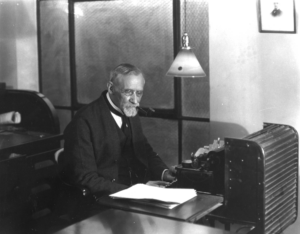It was January 1991. I walked into Rule High School knowing for sure what the students merely suspected. The bell calling for an assembly rang shortly after 1:30 p.m. Much to everyone’s chagrin, it was announced that the Knox County school board was closing the school. The age of the Golden Bears was coming to an end. After talking to several faculty members and students, I headed back to The Knoxville Journal to file my story.
Rule was not the only former Knoxville City School that met the chopping block when city voters abdicated the responsibility for education to Knox County back in the 1980s. Holston went by the wayside and South-Young merged into Doyle. Fulton barely escaped elimination.
While Holston became a middle school, the South-Young campus became a senior living facility and the home of the Knox County Museum of Education. No such future awaited Rule. The building was left to pretty much rot in place for over 30 years before demolition began a year ago. It was an ignominious end to a wonderful school named to honor one of the most accomplished mayors Knoxville ever had.
William Rule was a South Knox County kid. Born in 1839, he was the oldest of seven children born to Fredrick Rule and Sarah Elizabeth Brakebill. He was mostly informally and self-educated. By the late 1850s, he and his brother James were operating a general store at Cumberland Avenue and State Street. In 1858, he married a South Knox County girl named Lucy Ann Maxey.

William Rule in his new office at The Knoxville Journal in the Arcade Building, January 1925. (Photo credit: Thompson Brothers, C. M. McClung Historical Collection).
He and his brother closed up shop around 1860, which is when Rule decided it was time to pursue a career in journalism and went to work for the “Fightin’ Parson” William Gannaway Brownlow at his Knoxville Whig and Rebel Ventilator (see Betty Bean’s related story here). Brownlow was a legendary pro-Union, anti-secession agitator of those with Confederate sympathies. By 1861 and the start of the Civil War, Brownlow was in exile in Wears Valley. Rule kept printing newspapers and couriering messages to his boss.
By 1862, Rule’s life in Knoxville would be over for a few years. Like many a young man in East Tennessee who refused to betray the Union or risk conscription by the Confederacy, he walked his way to Kentucky, leaving behind his wife and the first two of his six children. The next four would have to wait till the war’s end. He returned with the rank of captain after joining Company A of the 6th Tennessee Infantry. He went back to the Whig but resigned in 1870 after the paper was sold to Thomas Mabry. He then started his own paper, The Knoxville Chronicle, the forebearer of The Knoxville Journal.
One of his early hires at The Chronicle was an 11-year-old boy from Cincinnati, Ohio. Adolph Ochs, a first-generation son of German Jewish immigrants, first started as Rule’s office assistant. Ochs would later have a controlling interest in The Chattanooga Time and go on to purchase and rehabilitate The New York Times. His descendants still own and operate the paper to this day.
Rule would first become Knoxville’s mayor in 1873. He would earn that title again 25 years later in 1898. He started a smallpox hospital and named its first superintendent, Dr. Swan Burnett (husband of The Secret Garden author Frances Hodgson Burnett) as well as starting construction on the city’s first public sewer. He was an active member of the veterans’ fraternity called the Grand Army of the Republic, but was unsuccessful in his efforts to make the actual Fort Sanders a national military park.
Rule published the Standard History of Knoxville, Tennessee in 1904, serving as chief contributor and editor. It is still an invaluable resource. Though he sold out of his interest in the Journal by the early 1900s, he remained the paper’s Republican editor for the rest of his life. He was 85 years old when operations were moved to the then sparkling new Journal Arcade building on Gay Street. In July 1928, Rule died at the age of 89 of acute appendicitis and was buried in Old Gray Cemetery. His wife joined him in the afterlife in December that same year. The home he built at what is now 1604 Clinch Avenue still stands.
Beth Kinnane writes a history feature for KnoxTNToday.com. It’s published each Tuesday and is one of our best-read features.
Sources: The French Broad-Holston Country: A History of Knox County, Tennessee ed. by Mary Rothrock, The Knoxville Journal digital archives, Heart of the Valley: A History of Knoxville, Tennessee ed. by Lucile Deaderick, Printer’s Devil to Publisher: Adolph S. Ochs of the New York Times by Doris Faber

